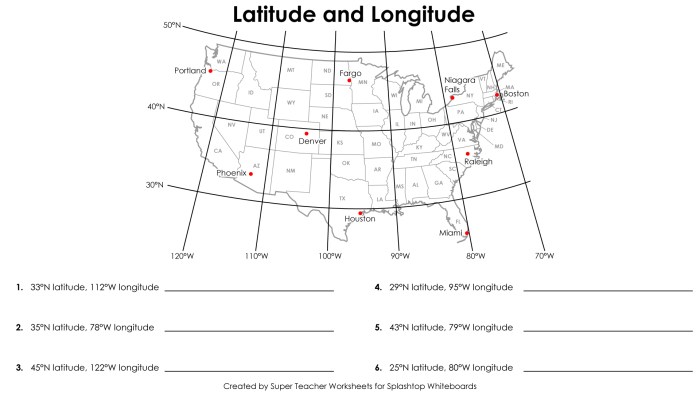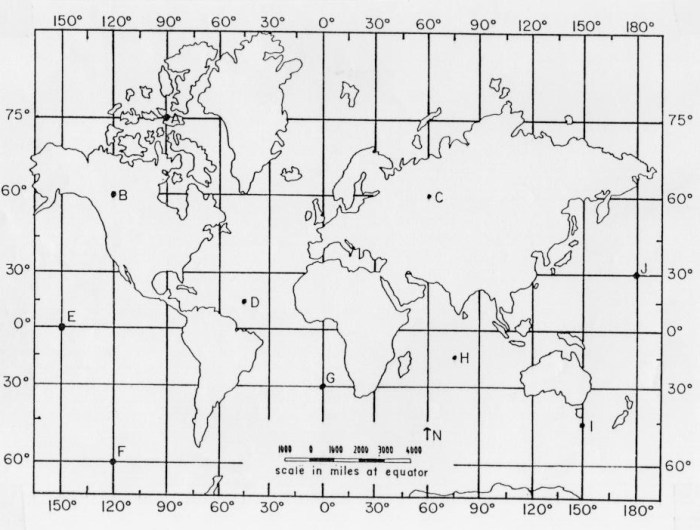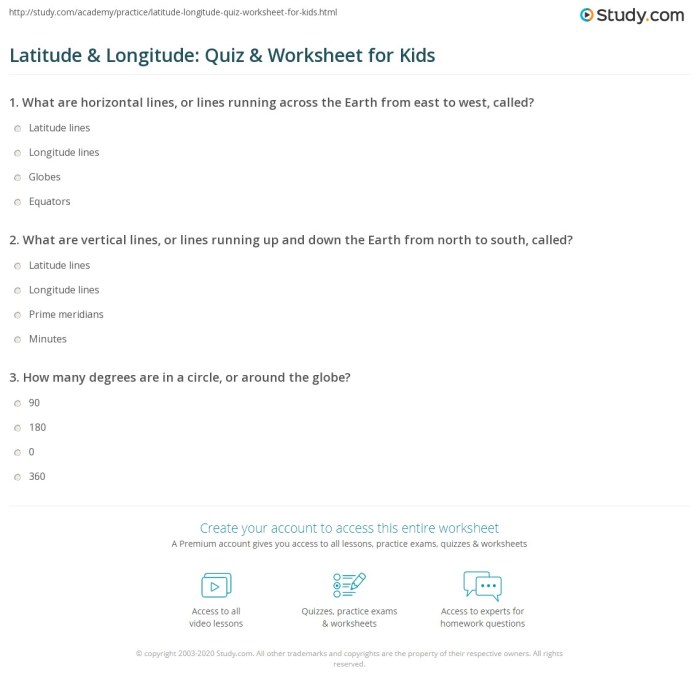Longitude and latitude practice worksheet – Embark on a captivating journey into the realm of longitude and latitude with our meticulously crafted practice worksheet. This comprehensive guide unravels the intricate system used to locate positions on Earth, empowering you with the knowledge to navigate the globe with precision and confidence.
Delve into the fundamentals of longitude and latitude, unraveling their interplay in determining geographic coordinates. Engage in interactive exercises that test your understanding and equip you with the practical skills to pinpoint locations with accuracy.
Longitude and Latitude: Longitude And Latitude Practice Worksheet

The concept of longitude and latitude is fundamental in geography. It provides a standardized system for locating positions on the Earth’s surface.
Understanding Longitude and Latitude
Longitude is an angular measurement that defines the east-west position of a location. It is measured in degrees east or west of the Prime Meridian, which passes through Greenwich, England.
Latitude, on the other hand, is an angular measurement that defines the north-south position of a location. It is measured in degrees north or south of the Equator.
Together, longitude and latitude form a coordinate system that allows us to pinpoint any location on Earth with great accuracy.
Practice Exercises
To practice determining longitude and latitude coordinates, refer to the provided table and locate the following coordinates on a map:
| Latitude | Longitude |
|---|---|
| 30°N | 90°W |
| 45°S | 150°E |
| 0° | 180° |
Applications of Longitude and Latitude
Longitude and latitude have numerous practical applications in various fields:
- Navigation:Coordinates are used by GPS devices, ships, and aircraft to determine their location and navigate.
- Cartography:Coordinates are essential for creating accurate maps and charts.
- Surveying:Coordinates are used to determine property boundaries and conduct land surveys.
- Geospatial analysis:Coordinates enable the analysis of spatial data and the creation of geographic information systems (GIS).
Historical Context, Longitude and latitude practice worksheet
The development of longitude and latitude as a coordinate system has a rich history:
- Early methods:Ancient civilizations used celestial bodies and landmarks to estimate their location.
- Eratosthenes:In the 3rd century BC, Eratosthenes calculated the Earth’s circumference with remarkable accuracy.
- Mercator’s projection:In the 16th century, Gerardus Mercator developed a map projection that distorted the Earth’s shape but made navigation easier.
- John Harrison:In the 18th century, John Harrison invented the marine chronometer, which revolutionized longitude determination.
Extensions
To further challenge your understanding, consider the following extensions:
- Worksheet:Design a worksheet that presents scenarios requiring the application of longitude and latitude knowledge to solve problems.
- Quiz:Create a quiz or assessment to evaluate students’ comprehension of the topic.
FAQ Corner
What is the difference between longitude and latitude?
Longitude measures the distance east or west of the Prime Meridian, while latitude measures the distance north or south of the Equator.
How are longitude and latitude used in navigation?
Longitude and latitude coordinates provide precise locations, enabling navigators to determine their position and plan their course.
What are some practical applications of longitude and latitude?
Longitude and latitude are used in cartography, surveying, weather forecasting, and many other fields that require precise geographic information.

